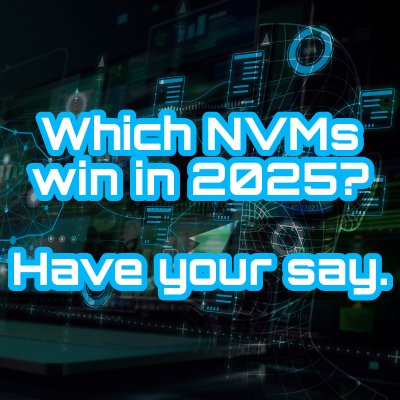Make a difference and take this short survey. It asks about your experience with embedded non-volatile memory technologies. The survey is anonymous, and the results will be shared in aggregate to help the industry better understand trends: 2025 Embedded Non-Volatile Memory Survey.
We are now in the AI era where data is the lifeblood of innovation, and embedded NVM stands as a cornerstone technology, retaining information without using power and enabling everything from MCUs and IoT SoCs to automotive controllers and secure elements.
As of November 2025, embedded NVM is moving fast. Edge data is surging, AI features are landing on MCUs and SoCs, and power budgets are tighter than ever. Memory is central to the devices we build. This survey looks at where eNVM stands today in terms of markets, technology, and adoption, and where it’s heading next.
Market Overview and Growth
Embedded emerging NVM, including MRAM, RRAM/ReRAM, and PCM, is entering a broader adoption phase across MCUs, connectivity, and edge-AI devices, with momentum building in automotive and industrial markets. Research firm Yole Group indicate the embedded emerging segment should exceed $3B by 2030, reflecting wider availability in mainstream process nodes and stronger pull where eFlash is no longer a good fit at ≤28 nm.
Technological Advancements
Embedded flash remains foundational, but scaling limits at advanced nodes have pushed MRAM, ReRAM, and embedded PCM to the foreground. Foundries and IDMs are extending embedded options beyond 28/22 nm planar CMOS toward 10–12 nm-class platforms, including FinFET. Yole highlights aggressive foundry roadmaps: TSMC has established high-volume MRAM/ReRAM and is preparing 12nm FinFET ReRAM/MRAM for 2025 and beyond. Samsung, GlobalFoundries, UMC, and SMIC are accelerating embedded MRAM/ReRAM/PCM across general-purpose MCUs and high-performance automotive designs. STMicroelectronics stands out as the IDM fully committed to embedded PCM, ramping xMemory solutions for industrial and automotive MCUs, with 18nm FD-SOI extending reach after 2025.
In parallel, BCD and HV-CMOS flows are incorporating embedded NVM as practical replacements for EEPROM/OTP in analog, power management, and mixed-signal designs. On the IP side, suppliers are qualifying embedded NVM technologies for these platforms, giving designers more options where cost, endurance, and retention outweigh legacy choices. Beyond code and data storage, in-/near-memory compute concepts using eNVM are gaining interest for low-power edge AI inference.
Drivers, Challenges, and Use Cases
Automotive remains the center of gravity for embedded emerging NVM, and 2025 brings a noticeable uptick in secure ICs and industrial MCUs as more products reach production. In practice, ReRAM, MRAM, and PCM each have a role: ReRAM is gaining traction in several high-volume categories; MRAM and PCM are attractive where speed and endurance dominate. The mix varies by node, application, and vendor roadmap.
The challenges are familiar: integrating eNVM at advanced logic nodes, trading off endurance and retention, qualifying to automotive-grade reliability, and achieving cost-effective density as embedded code and AI parameters grow. The trend line is positive, with PDK/IP availability growing and capacity ramping, so these issues are being addressed rather than deferred.
Outlook
By 2030, embedded NVM will underpin more on-chip AI features and practical in-/near-memory compute blocks, with broader use in neuromorphic-inspired accelerators at the edge. Yole’s projections indicate that the embedded emerging segment is now the primary engine of growth, led by ReRAM in high-volume MCUs and analog ICs, while MRAM and embedded PCM consolidate in performance-critical niches. As edge data grows, eNVM’s role expands from “just storage” to part of the computing fabric, redefining efficiency and making embedded memory more central than ever to device intelligence.
Bottom line: In 2025, embedded NVM isn’t just memory, it’s the enabler of intelligent, persistent systems on chip. With accelerating adoption across MCUs and edge SoCs, and clear roadmaps from leading foundries and IDMs, the trajectory is set: embedded memory matters more than ever. Let us know your opinion by taking the short survey.
Take the 2025 Embedded Non-Volatile Memory Survey Here.
Also Read:
Chiplets: Powering the Next Generation of AI Systems
Podcast EP312: Approaches to Advance the Use of Non-Volatile Embedded Memory with Dave Eggleston
Podcast EP311: An Overview of how Keysom Optimizes Embedded Applications with Dr. Luca TESTA
Share this post via:







The Quantum Threat: Why Industrial Control Systems Must Be Ready and How PQShield Is Leading the Defense